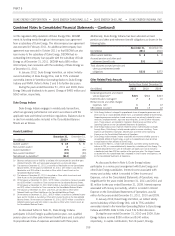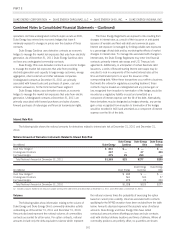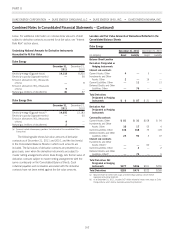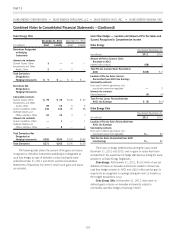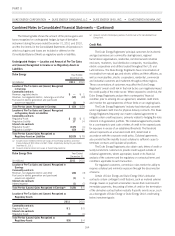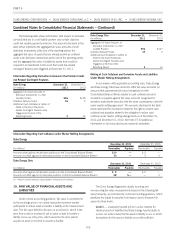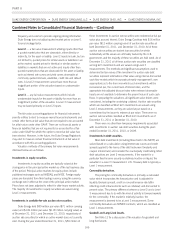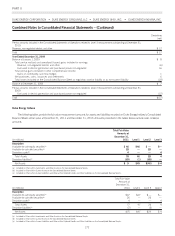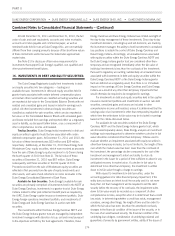Duke Energy 2011 Annual Report Download - page 184
Download and view the complete annual report
Please find page 184 of the 2011 Duke Energy annual report below. You can navigate through the pages in the report by either clicking on the pages listed below, or by using the keyword search tool below to find specific information within the annual report.
PART II
DUKE ENERGY CORPORATION •DUKE ENERGY CAROLINAS, LLC •DUKE ENERGY OHIO, INC. •DUKE ENERGY INDIANA, INC.
Combined Notes to Consolidated Financial Statements – (Continued)
Thefollowingtableshowstheamountofthepre-taxgainsand
losses recognized on undesignated hedges by type of derivative
instrument during the years ended December 31, 2011 and 2010,
and the line item(s) in the Consolidated Statements of Operations in
which such gains and losses are included or deferred on the
Consolidated Balance Sheets as regulatory assets or liabilities.
Undesignated Hedges — Location and Amount of Pre-Tax Gains
and (Losses) Recognized in Income or as Regulatory Assets or
Liabilities
Duke Energy Year Ended
December 31,
(in millions) 2011 2010
Location of Pre-Tax Gains and (Losses) Recognized
in Earnings
Commodity contracts
Revenue, regulated electric $— $1
Revenue, non-regulated electric, natural gas and other (59) (38)
Fuel used in electric generation and purchased
power-non-regulated (1) 9
Total Pre-tax Losses Recognized in Earnings $ (60) $(28)
Location of Pre-Tax Gains and (Losses) Recognized
as Regulatory Assets or Liabilities
Commodity contracts
Regulatory Asset $(1) $5
Regulatory Liability 17 14
Interest rate contracts
Regulatory Asset(a) (165) (1)
Regulatory Liability(b) (60) 60
Total Pre-tax (Losses) Gains Recognized as
Regulatory Assets or Liabilities $(209) $78
(a) Includes losses related to interest rate swaps at Duke Energy Carolinas and Duke
Energy Indiana of $94 million and $67 million, respectively, during the year ended
December 31, 2011.
(b) Amounts relate to interest rate swaps at Duke Energy Carolinas.
Duke Energy Ohio Year Ended
December 31,
(in millions) 2011 2010
Location of Pre-Tax Gains and (Losses) Recognized in
Earnings
Commodity contracts
Revenue, non-regulated electric and other (26) (3)
Fuel used in electric generation and purchased
power-non-regulated (1) 9
Interest rate contracts
Interest expense (1) (1)
Total Pre-tax (Losses) Gains Recognized in Earnings(a) $(28) $5
Location of Pre-Tax Gains and (Losses) Recognized as
Regulatory Assets
2011 2010
Commodity contracts
Regulatory Asset $1 $5
Interest rate contracts
Regulatory Asset (4) (1)
Total Pre-tax (Losses) Gains Recognized as
Regulatory Assets $(3) $4
(a) Amounts include intercompany positions that eliminate at the consolidated Duke
Energy level.
Credit Risk
The Duke Energy Registrants’ principal customers for its electric
and gas businesses are commodity clearinghouses, regional
transmission organizations, residential, commercial and industrial
end-users, marketers, local distribution companies, municipalities,
electric cooperatives and utilities located throughout the U.S. and
Latin America. The Duke Energy Registrants have concentrations of
receivables from natural gas and electric utilities and their affiliates, as
well as municipalities, electric cooperatives, residential, commercial
and industrial customers and marketers throughout these regions.
These concentrations of customers may affect the Duke Energy
Registrants’ overall credit risk in that risk factors can negatively impact
the credit quality of the entire sector. Where exposed to credit risk, the
Duke Energy Registrants analyze their counterparties’ financial
condition prior to entering into an agreement, establish credit limits
and monitor the appropriateness of those limits on an ongoing basis.
The Duke Energy Registrants’ industry has historically operated
under negotiated credit lines for physical delivery contracts. The Duke
Energy Registrants frequently use master collateral agreements to
mitigate certain credit exposures, primarily related to hedging the risks
inherent in its generation portfolio. The collateral agreements provide
for a counterparty to post cash or letters of credit to the exposed party
for exposure in excess of an established threshold. The threshold
amount represents an unsecured credit limit, determined in
accordance with the corporate credit policy. Collateral agreements
also provide that the inability to post collateral is sufficient cause to
terminate contracts and liquidate all positions.
The Duke Energy Registrants also obtain cash, letters of credit or
surety bonds from customers to provide credit support outside of
collateral agreements, where appropriate, based on its financial
analysis of the customer and the regulatory or contractual terms and
conditions applicable to each transaction.
For regulated customers, commission rules restrict the ability to
requires collateral and minimize exposure through the disconnection
of service.
Certain of Duke Energy and Duke Energy Ohio’s derivative
contracts contain contingent credit features, such as material adverse
change clauses or payment acceleration clauses that could result in
immediate payments, the posting of letters of credit or the termination
of the derivative contract before maturity if specific events occur, such
as a downgrade of Duke Energy or Duke Energy Ohio’s credit rating
below investment grade.
164







